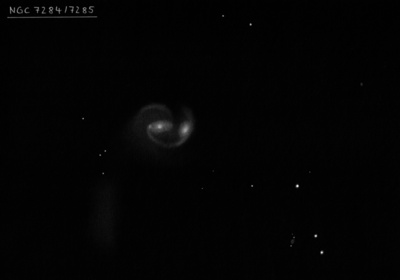
William Herschel discovered NGC 7284 = H II-469 = h3943 on 26 Oct 1785 (sweep 465) and recorded "F, er [easily resolvable] or some of the stars visible; pS, lE." Perhaps one the "stars" was the second nucleus (NGC 7285). From the Cape of Good Hope, JH logged (sweep 474) "F; E; bM; r; binuclear pos 62.3°. Rather an equivocal object, whether nebulous or a group, but I incline to regard it as a nebula." On a later sweep (14 Sep 1835), he wrote "pB; irr R; 25"; involves a double star (13m + 14m)." So, he clearly resolved the two nuclei.
Herbert Howe reported NGC 7284 and 7285 as follows: "The description of 7284 in the NGC is "cF, cS, lE, r, D * inv." The description of 7285, discovered by Lassell [Marth], is "Nebs. * 1' dist from 7284." I judge 7285 to be simply one of the components of 7284. Both seem to be nebulous stars. The brighter one is of mag 12.5 The other is of mag 13, and lies at P.A. 60°, distant about 40". Neither of the stars appeared to be double. I could not see any nebulosity uniting them, but the sky was rather dull."
400/500mm - 17.5" (10/13/90): fairly faint, very small, very compact, almost round, high surface brightness, very small very bright core, stellar nucleus. Forms a contact pair with NGC 7285 at the ENE edge with a separation of 30" between centers.
600/800mm - 24" (8/23/14): at 375x, the western component of the double system VV 74 = Arp 93 appeared bright, small, round, high surface brightness, ~0.4' diameter. The core of NGC 7285 is cleanly resolved [33" between center], though very close northeast. The twin nuclei are encased in a very low surface brightness halo.
Notes by Steve Gottlieb